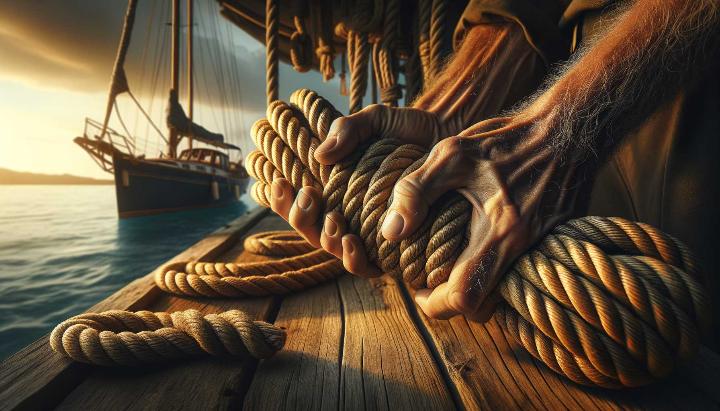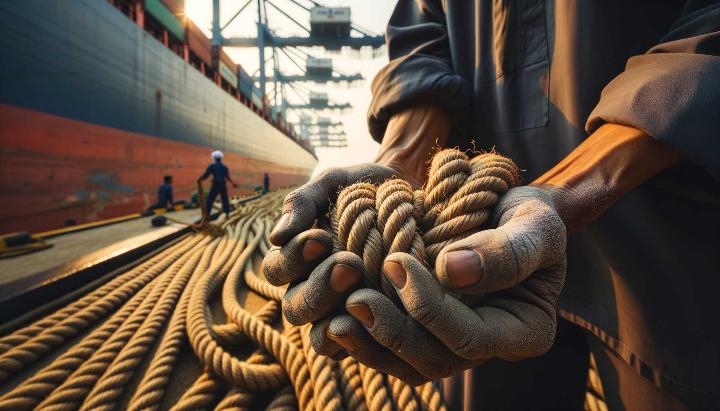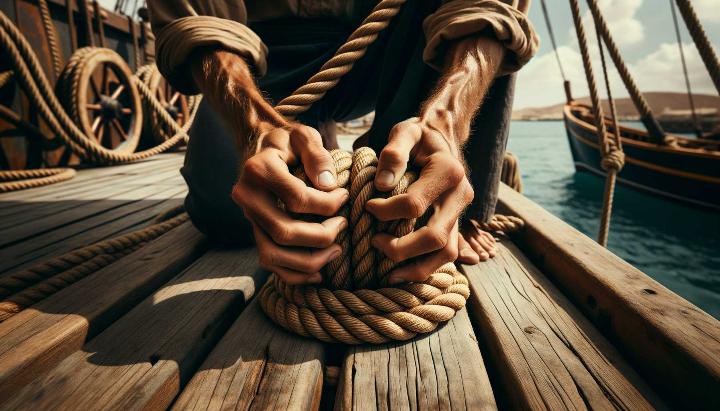Have you ever found yourself in a situation where the strength of your rope could mean the difference between success and failure? Whether you're a seasoned sailor, an adventure enthusiast, or a professional in industries relying on robust rigging solutions, understanding the intricacies of multi plait rope and mastering the art of splicing can be game-changing.
At iRopes, with our 15 years of production experience, we've seen firsthand how the right rope can transform a challenging task into a smooth operation. That's why we're excited to dive into the world of multi plait and multi strand ropes, exploring their unique characteristics and unravelling the secrets of splicing 8 plait rope to chain.
In this comprehensive guide, we'll take you on a journey through the robust fibres of multi plait rope, compare it with its multi strand counterpart, and equip you with the knowledge to perform a professional splice. Whether you're looking to enhance your maritime skills or seeking customised rope solutions for your business, this post will serve as your go-to resource. Get ready to elevate your rope game and discover how our expert customisation services can meet your most demanding requirements.
Understanding Multi Plait Rope: Construction and Benefits
Have you ever marvelled at the intricate design of a multi plait rope? As someone who's spent countless hours on the water, I can tell you that understanding these ropes is crucial for any serious boater or maritime professional. Let's dive into the world of multi plait ropes and discover why they're a game-changer in the marine industry.
8-Strand Plait Rope: Characteristics and Uses
Picture a rope that's not just strong, but also incredibly flexible and resistant to kinking. That's the beauty of 8-strand plait rope. The construction involves eight individually braided strands, woven together in a complex pattern that results in a rope that's both sturdy and supple.
I remember the first time I handled an 8-strand plait rope - it was like discovering a new tool that made everything easier. The rope flowed through my hands smoothly, yet I could feel the inherent strength in its fibres. It's this unique combination of flexibility and strength that makes multi plait ropes ideal for a variety of maritime applications.

Comparing Multi Plait to Other Rope Types
When it comes to choosing the right rope for your needs, it's essential to understand how multi plait ropes stack up against other options. Let's break it down:
- Strength-to-weight ratio: Multi plait ropes typically offer a superior strength-to-weight ratio compared to 3-strand ropes, making them ideal for applications where weight is a concern.
- Flexibility: The 8-strand construction allows for greater flexibility than double braid ropes, which can be advantageous in situations requiring intricate knot work or frequent bending.
- Abrasion resistance: While not as abrasion-resistant as some double braid ropes, multi plait ropes still offer excellent durability in most marine environments.
- Handling: The smooth surface of multi plait ropes makes them easier to handle and less prone to snagging compared to 3-strand ropes.
In my experience, multi plait ropes excel in applications such as anchor lines, where their shock-absorbing properties and ease of handling make a real difference. They're also fantastic for mooring lines, offering a great balance of strength and flexibility.
Have you ever used a multi plait rope for your boating needs? If not, you might be surprised at how much of a difference it can make. The next time you're out on the water, pay attention to how your ropes perform - you might find that upgrading to a multi plait rope could enhance your boating experience significantly.
Pro tip: When choosing a multi plait rope, consider factors like the intended use, environmental conditions, and required load capacity to ensure you select the right rope for your specific needs.
Understanding multi plait ropes is just the beginning. In the next section, we'll explore how these versatile ropes compare to multi strand ropes, and dive deeper into their unique advantages. Stay tuned to learn more about mastering the art of rope selection for your maritime adventures!
Introduction to Multi-Strand Rope: Definition and Basic Concepts
As we dive deeper into the world of ropes, it's time to explore another fascinating type: multi-strand rope. Having spent years working with various rope constructions, I can tell you that multi-strand ropes are a game-changer in many industries. But what exactly are they, and how do they differ from the multi plait ropes we discussed earlier?
Types of Multi-Strand Rope Constructions
Multi-strand ropes are marvels of engineering, consisting of several strands twisted or braided around a central core. The most common types you'll encounter are 6-strand and 8-strand constructions. Each configuration offers unique properties that cater to specific needs.
One crucial aspect of multi-strand ropes is the core. You'll typically find two main types:
- Fiber Core (FC): Made from natural or synthetic fibers, providing flexibility and lightweight properties.
- Independent Wire Rope Core (IWRC): A smaller wire rope within the main rope, offering increased strength and stability.
The choice between FC and IWRC can significantly impact the rope's performance. I remember a project where switching from FC to IWRC in a heavy-lifting application improved the rope's lifespan by nearly 30%!

Applications and Advantages of Multi-Strand Ropes
Multi-strand ropes shine in various industries due to their unique characteristics. Have you ever wondered why certain ropes are preferred in specific applications? Let's break it down:
- Superior strength: Multi-strand ropes often boast higher breaking strengths compared to single-strand alternatives, making them ideal for heavy-lifting operations in construction and marine industries.
- Enhanced flexibility: The multiple strand construction allows for greater bending without compromising strength, perfect for applications involving pulleys or winches.
- Resistance to rotation: This is crucial in lifting operations where load stability is paramount. I've seen multi-strand ropes outperform others in crane operations, keeping loads steady even in challenging conditions.
From offshore oil rigs to mining operations, multi-strand ropes have proven their worth time and again. Their versatility and durability make them a top choice for demanding environments where failure is not an option. Learn more about maximizing strength and versatility by exploring our high-performance yacht and sailing ropes.
As we continue to push the boundaries of engineering and explore new frontiers, the role of multi-strand ropes becomes increasingly vital. Whether you're in the maritime industry, construction, or any field that relies on robust rope solutions, understanding the nuances of multi-strand ropes can give you a significant advantage.
Pro tip: When selecting a multi-strand rope, consider not just the immediate application but also the long-term cost benefits. A higher initial investment in a quality multi-strand rope can lead to significant savings in maintenance and replacement costs down the line.
As we delve deeper into the world of ropes, remember that each type has its unique strengths. In the next section, we'll explore how our factory's 15 years of experience translates into creating customised multi-strand rope solutions that meet the most demanding specifications. Stay tuned to discover how we can tailor these remarkable ropes to your specific needs!
Mastering the Art of Splicing 8 Plait Rope to Chain
As a seasoned sailor, I can't stress enough how crucial it is to master the art of splicing 8 plait rope to chain. This skill is not just a fancy trick; it's a fundamental technique that can significantly enhance your boat's safety and performance. Let me take you through the process, sharing some insights I've gained over years of hands-on experience.
Understanding 8 Plait Rope Structure
Before we dive into the splicing process, it's essential to understand the unique structure of 8 plait rope. Unlike its 3-strand counterpart, 8 plait rope is composed of four pairs of strands, interwoven in a complex pattern. This construction gives the rope its characteristic smoothness and flexibility, making it a favourite among sailors for various applications.
When you're preparing to splice, you'll need to mentally divide the rope into these four pairs. This conceptual division is key to creating a strong, reliable splice. I remember the first time I attempted this splice - it seemed daunting at first, but once I understood the rope's structure, everything fell into place.

Step-by-Step Guide to Splicing
Now, let's walk through the splicing process. Remember, practice makes perfect, so don't be discouraged if your first attempt isn't flawless.
- Prepare your materials: You'll need your 8 plait rope, the chain, a fid (a tapered tool for separating strands), scissors, and whipping twine.
- Measure and mark: Measure about 30 times the rope's diameter from the end and mark it. This is where you'll start unravelling.
- Unravel the rope: Carefully separate the strands up to your mark. You should have four pairs of strands.
- Prepare the chain: Thread the rope through the last link of the chain.
- Begin tucking: Start with one pair of strands, tucking it over one strand of the standing part and under the next.
- Continue the pattern: Repeat this process with the remaining three pairs, always going over one and under one.
- Taper the splice: After 5-7 tucks, start tapering by dropping one strand from each pair.
The key to a secure splice is maintaining even tension throughout the process. I find it helpful to pause occasionally and adjust the tightness of each tuck.
Tools and Materials Needed
Having the right tools can make all the difference in creating a professional-grade splice. Here's what you'll need:
- Fid: This is your most important tool. Choose one that matches your rope's diameter.
- Sharp scissors: Clean cuts are crucial for a neat splice.
- Whipping twine: Use this to secure the end of your splice and prevent unravelling.
- Measuring tape: Accuracy is key in splicing.
- Marker: For marking your starting point and tucks.
Pro tip: Invest in a good quality fid. It's the workhorse of splicing and will make your job much easier and more precise.
Remember, splicing is as much an art as it is a science. With practice, you'll develop a feel for the rope and chain, creating splices that are not only strong but also aesthetically pleasing. Happy splicing, and may your connections always hold fast! Discover more about customizing rope solutions to meet your unique needs at iRopes.
Customizing Multi-Strand Rope: Options and Techniques
As someone who's worked with ropes for over two decades, I can tell you that the world of multi-strand rope customization is as vast as it is fascinating. Whether you're a seasoned sailor or a DIY enthusiast, understanding the options available can truly elevate your rope game. Let's dive into the exciting realm of personalized rope solutions!
Personalizing Multi-Plait Designs for Unique Rope Creations
Multi-plait ropes offer a canvas for creativity that's often overlooked. I remember the first time I experimented with custom plaiting - it was like discovering a whole new dimension of rope craftsmanship. Here are some techniques that can transform ordinary ropes into extraordinary creations:
- Intricate braiding patterns: By altering the standard plaiting sequence, you can create eye-catching designs that are as functional as they are beautiful.
- Incorporating unique materials: Imagine weaving reflective threads or even LED strands into your rope for added visibility and style.
- Custom rope thickness: Tailor the rope's diameter to your specific needs, ensuring the perfect balance of strength and flexibility.
One of my favourite projects involved creating a custom multi-plait rope for a luxury yacht. We incorporated the owner's initials into the braiding pattern - a subtle yet elegant touch that made the mooring lines truly one-of-a-kind.

Color Customization in Multi-Strand Rope Products
Color isn't just about aesthetics - it can significantly impact a rope's functionality and safety. Here's how you can leverage color customization:
- High-visibility options: Bright colors like neon yellow or orange can enhance safety in marine or construction environments.
- Brand-aligned hues: Match your ropes to your company colors for a cohesive look across all your equipment.
- Color-coding systems: Use different colors to quickly identify rope types, strengths, or intended uses.
I once worked with a rock climbing gym that used our color customization service to create a unique training system. Each rope color corresponded to a different difficulty level, making it easy for climbers to choose routes appropriate for their skill level.
Pro tip: When selecting colors for outdoor use, consider UV-resistant dyes to maintain vibrant hues even after prolonged sun exposure.
At our factory, with 15 years of production experience, we've honed our skills in rope customization to meet even the most unique requests. Our independent preparation equipment allows us to tailor every aspect of your rope, from the core material to the outer braiding pattern.
Have you ever considered how a custom-designed rope could enhance your project or business? Whether it's for practical purposes or to make a statement, personalized multi-strand ropes offer endless possibilities. Feel free to reach out and explore how we can bring your vision to life! To see more on our customization capabilities, visit our Customization page.
Delving into the world of multi plait rope and multi strand rope, this blog post illuminates their unique benefits, including superior flexibility, strength, and diverse applications, particularly in the marine industry. Additionally, it underscores the importance of proper splicing techniques, offering a detailed guide to splicing 8 plait rope to chain, showcasing both the necessary tools and the best practices. With 15 years of production experience, our factory excels in personalised customisation, ensuring that our ropes meet specific customer needs precisely. Discover the intricacies of rope selection and splicing, and elevate your boating experience with our expertly crafted multi plait and multi strand ropes.
Contact Us for Custom Rope Solutions
Our team is eager to assist you with your unique requirements. Fill in the form above to get in touch and learn more about our customised rope solutions tailored to your needs.